|
Report from
Europe
European wood furniture production down 5% last
year
The latest Eurostat PRODCOM data reveals that the total
value of wood furniture production in the EU27 declined
5% to €32.4 billion in 2020. This performance for the year
is significantly better than initially anticipated at the start
of the pandemic.
It is also an improvement on the 8% decline in total EU27
furniture production in 2020 implied by the Eurostat
furniture production index published earlier this year.
Nevertheless, the decline was a major setback for a sector
that has been sliding since 2018. Production value last
year was the lowest since 2014 when the EU27 was just
emerging from the depths of the Euro Debt Crisis in the
aftermath of the 2007-2008 global financial crash (Chart
1).
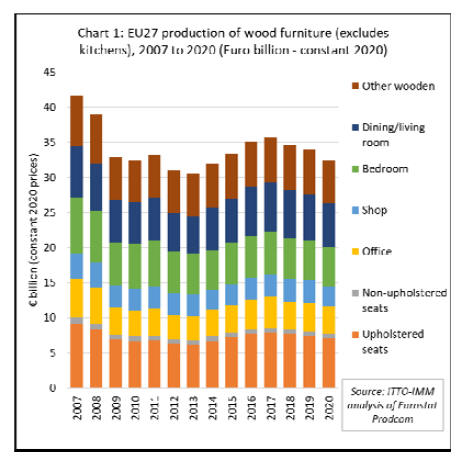
The production downturn in 2020 was particularly
dramatic for shop furniture which saw a decline of 13% to
€2.8 billion. This was the result of widespread closure of
retail outlets and increased reliance on online shopping as
much of Europe went into lockdown early in the
pandemic.
The decline was much less severe in other sectors
including upholstered seating (-5% to €7.0 billion), office
furniture (-1% to €4.0 billion), bedroom furniture (-3% to
€2.8 billion), dining/living room (-4% to €6.3 billion), and
"other wooden furniture" (-6% to €6 billion). Production
value of non-upholstered seating was flat at €0.6 billion.
Wooden furniture production value in Italy, the largest
producer in the EU27, increased last year, rising 4% to
€8.0 billion and recovering ground lost in 2019.
Production was down in all other leading supply countries
including Poland (-3% to €5.9 billion), Germany (-8% to
€5.7 billion), Spain (-11% to €1.9 billion), France (-17%
to €3.2 billion), Romania (-9% to €1.5 billion). Lithuania
(-2% to €1.4 billion), Portugal (-7% to €1.0 billion), and
Denmark (-5% to €0.8 billion) (Chart 2).
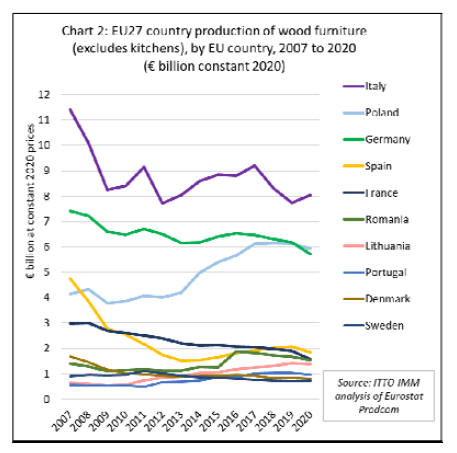
The value EU27 wooden furniture consumption fell 4% to
€28.3 billion in 2020. As for production, the consumption
downturn was most pronounced for wooden shop
furniture, down 10% at €2.4 billion. The total value of
EU27 consumption of wooden office furniture increased in
2020, rising 1% to US$3.6 billion, probably a result of
workers purchasing office equipment for their own homes
during the lockdown.
Consumption of all other furniture types declined in 2020
including upholstered seating (-6% to €6.0 billion), other
seating (-5% to €0.7 billion), bedroom furniture (-4% to
€5.0 billion), dining/living room (-4% to €5.7 billion), and
"other wooden furniture" (-4% to €5 billion).
Wooden furniture consumption in Germany, by far the
largest single market in the EU27, was relatively stable in
2020, as it has been for the last 4 years, falling only 2% to
€8.2 billion. Italy, again surprising given the severe effects
of the pandemic in the country during the year, recorded
an 8% increase in wood furniture consumption value in
2020, to €4.9 billion.
Gains in consumption were also recorded in Austria (+5%
to €0.8 billion) and Sweden (+7% to €0.8 billion).
Elsewhere there were large falls in consumption in France
(-12% to €3.6 billion), Spain (-12% to €1.9 billion), the
Netherlands (-11% to €1.3 billion), Romania (-7% to €1.0
billion), and Poland (-22% to €1.0 billion).
Consumption in Belgium was flat at €0.8 billion during
the year (Chart 4).
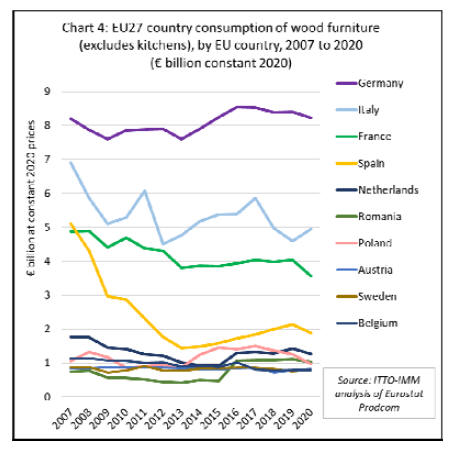
EU27 wood furniture imports from tropical countries
hit by freight problems
In 2020, the EU27 imported €4.5 billion of wooden
furniture from outside the bloc, only 0.3% less than the
previous year. Imports of €1.1 billion from the tropics
were down 4% at €1.1 billion, while imports from China
fell 2% to €2.0 billion.
In contrast imports from other countries outside the tropics
increased 5% to €1.4 billion. The large decline from
tropical countries was partly due to the severe shortages of
containers and sharp rises in freight rates for shipments
from Southeast Asia to Europe during the year.
However, this is also a continuation of a long term trend of
rising share of EU27 wooden furniture supplies being
sourced from other temperate countries, particularly in the
European neighbourhood, notably Turkey, Bosnia
Herzegovina, Ukraine, Belarus and Serbia (Chart 5).
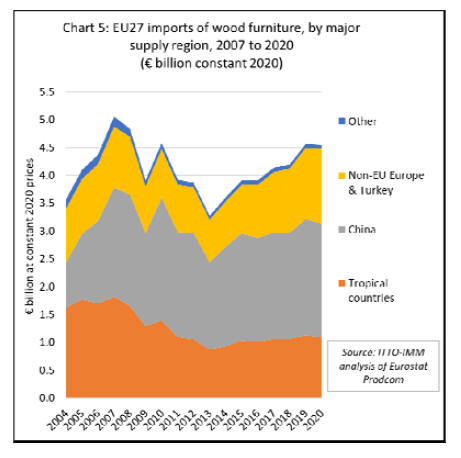
In recent years, tropical countries have made some slight
gains in the EU27 market for wooden furniture, with their
total share of consumption value rising slowly from 3.5%
in 2014 to 3.8% in 2019, a level maintained into 2020,
despite pandemic-related problems.
Vietnam's share crept up from 1.4% to 1.6%, Indonesia's
from 0.9% to 1%, and India's from 0.5% to 0.7% during
this period.
However, these gains came only after a long period of
decline between 2007 and 2014. Before the global
financial crises, tropical countries accounted for around
5% of all wooden furniture consumed in the EU27.
The long-term shift away from tropical suppliers in the
EU27 wood furniture market was due particularly to loss
of share for tropical wood in the outdoor sector, both to
other wood products and, more significantly, to non-wood
materials.
Furniture manufacturers in tropical countries have so far
been relatively unsuccessful in accessing EU markets for
interior furniture - unlike in the United States where
tropical countries, particularly Vietnam, are rapidly
increasing share.
To put EU27 wood furniture imports from tropical
countries into perspective, it can be noted that the total
value last year ¨C in dollar terms around USD1.24 billion
from all tropical countries - was slightly less than
USD1.26 billion of US wood furniture imports just from
Vietnam in the month of July this year.
Meanwhile, in recent years, larger gains in the EU27 wood
furniture market were made by Chinese suppliers, whose
share of EU27 consumption increased from 6.7% in 2014
to 7.2% in 2020, and by other temperate suppliers, rising
from 3.3% to 5.0% over the same period.
These gains were at the expense of domestic producers,
but only around the margins without at all threatening the
overwhelming market dominance of EU27 manufacturers.
Domestic production in the EU27 accounted for around
84% of all wood furniture consumption in the EU27 in
2020, a decline from 87% in 2014.
EU27 imports of wooden furniture have picked up pace
this year, although again suppliers outside the tropics have
benefited more than tropical suppliers (Chart 6).
The total import value in the first seven months of 2021
was €3.3 billion, 35% more than the same period in 2020
when much of the continent was operating under strict
lockdown conditions. However, import value during the
seven month period was also up 22% compared to the
same period in 2019.

While it is a positive sign that EU27 importers are willing
to spend more on wooden furniture from tropical countries
this year, these gains in import value must be seen against
the background of a five-fold increase in freight rates from
Southeast Asia to Europe between September 2020 and
July this year. Many tropical manufacturers are probably
benefitting very little in terms of improved sales value.
EU27 wood furniture import value from China in the first
seven months this year was €1.47 billion, 40% and 21%
more than the same period in 2020 and 2019 respectively.
The equivalent figure for import value from tropical
countries was €850 million, up 28% and 19% compared to
2020 and 2019 respectively.
Import value from other countries (almost all neighbouring
countries in Europe outside the EU) in the first seven
months was €970 million, up 33% and 26% compared to
2020 and 2019 respectively.
Of the main tropical suppliers of wooden furniture to the
EU27, import value from Vietnam was €340 million in the
first seven months of 2021, 16% and 15% more than the
same period in 2020 and 2019 respectively. Import value
from Indonesia was €216 million, up 23% compared to
2020 and 25% compared to 2019.
India made even more spectacular gains, import value of
€171 million in the first seven months this year being 71%
and 36% more than the same period in 2020 and 2019
respectively.
Growth in import value of €67 million from Malaysia was
more modest, up 53% compared to 2020 but only 14%
more than 2019. Import value of €32 million from Brazil
was just 10% and 16% more than the same period in 2020
and 2019 respectively.
The import value from Thailand, at €15 million, was still
3% down compared to the first seven months of 2020 and
34% less than the same period in 2019 (Chart 7).
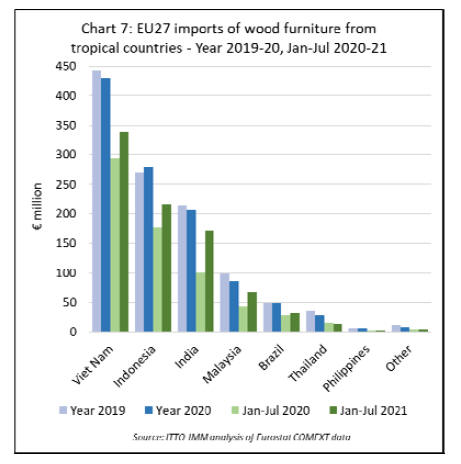
There were universal gains in import value of wooden
furniture from tropical countries across all the leading
EU27 markets in the first seven months this year
including:
Germany (€187 million, +26% on 2020 and
+19% on 2019),
France (€177 million, +27% on 2020 and +15%
on 2019),
Netherlands (€151 million, +27% on 2020 and
+13% on 2019),
Belgium (€74 million, +35% on 2020 and +48%
on 2019),
Spain (€54 million, +24% on 2020 and +25% on
2019),
Denmark (€40 million, +43% on 2020 and +48%
on 2019)
Italy (€32 million, +14% on 2020 and +6% on
2019)
See Chart 8.
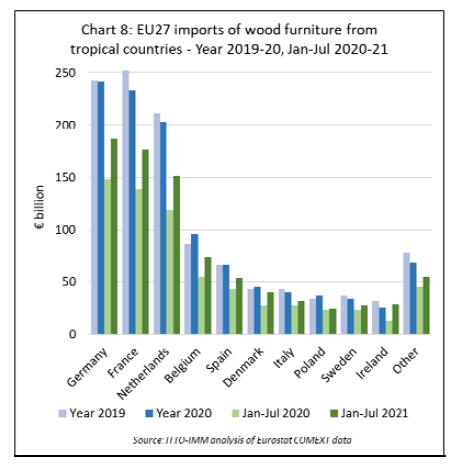
Procedures for assessing effectiveness of EUTR are
inadequate - European Court of Auditors
In a report published 4 October, the European Court of
Auditors concluded that EC procedures for assessing
effectiveness of the EU Timber Regulation (EUTR) are
inadequate.
In the Special Report 21/2021: EU funding for
biodiversity and climate change in EU forests: positive but
limited results", the Court of Auditors conclude that:
"Reporting under the Timber Regulation does not provide
the information with which the Commission can analyse
the quality of Member States¡¯ monitoring activity, the
national rules defining illegal logging or the procedures
used for checks. Nor does it require Member States to
substantiate their replies with supporting documents that
would allow it to verify the accuracy or completeness of
the information¡±.
The Court goes on to note that ¡°we reviewed the national
procedures for checking domestic logging in Germany,
Spain and Poland in order to assess the content and extent
of the checks and confirm the importance of the
Commission¡¯s role in monitoring. We found that
procedural weaknesses and missing checks reduce the
Timber Regulation¡¯s effectiveness in practice¡±.
As background, the Court of Auditors note that the EUTR
prohibits the placing of illegally harvested timber and
timber products on the EU market. In general, illegal
logging means any illegal practices relating to the
harvesting or trading of timber and timber products.
The rules in place in the Member State define whether
timber is illegally harvested. To minimise the risk of
illegally harvested timber reaching the market the Timber
Regulation requires operators to exercise due diligence. To
this end, they must collect information on timber type,
country of harvest, supply chain and compliance with the
rules, assessing any risk and, where necessary, taking
remedial action.
According to the Court of Auditors, in 2020, the European
Commission (EC) published a report on Member States¡¯
checks under the Regulation. According to the EC report,
all Member States were compliant with the formal
requirements of the Regulation.
The Commission concluded that, despite progress,
continuous efforts were needed to ensure that the
Regulation was put into practice consistently and
effectively in all Member States. It found that the number
of checks remained low compared to the number of
operators and doubted that these low frequency checks
would have a dissuasive effect.
According to the EC report, there were an estimated
3,042,884 domestic operators in 21 Member States, and
checks were made on 13,078 (0.43 %) during the two-year
reporting period. The next review of the effectiveness of
the Timber Regulation, together with a fitness check, is
due in December 2021.
The Court of Auditors go on to explain that the EC is
responsible for reviewing the functioning and
effectiveness of the Timber Regulation. Member State
reporting is the main source of information for its reviews.
The Timber Regulation requires Member States to make
available information on the application of the regulation
and leaves it up to the Commission to establish a format
and procedure by an implementing act.
The Commission has not issued an implementing act but it
has set up an online reporting system to collect
information on Member State checks in a standardised
way.
According to the Court of Auditors, ¡°Reporting focuses on
the risk criteria for selecting operators, the number of
checks, the time taken for checks, the type of information
recorded, and penalties.
Reporting under the Timber Regulation does not provide
the information with which the Commission can analyse
the quality of Member States¡¯ monitoring activity, the
national rules defining illegal logging or the procedures
used for checks. Nor does it require Member States to
substantiate their replies with supporting documents that
would allow it to verify the accuracy or completeness of
the information¡±.
The Court of Auditors report is available at
https://www.eca.europa.eu/en/Pages/DocItem.aspx?did=59368
The Court¡¯s analysis of EUTR is in paragraphs 33-39 starting at
page 23 of the report.
|